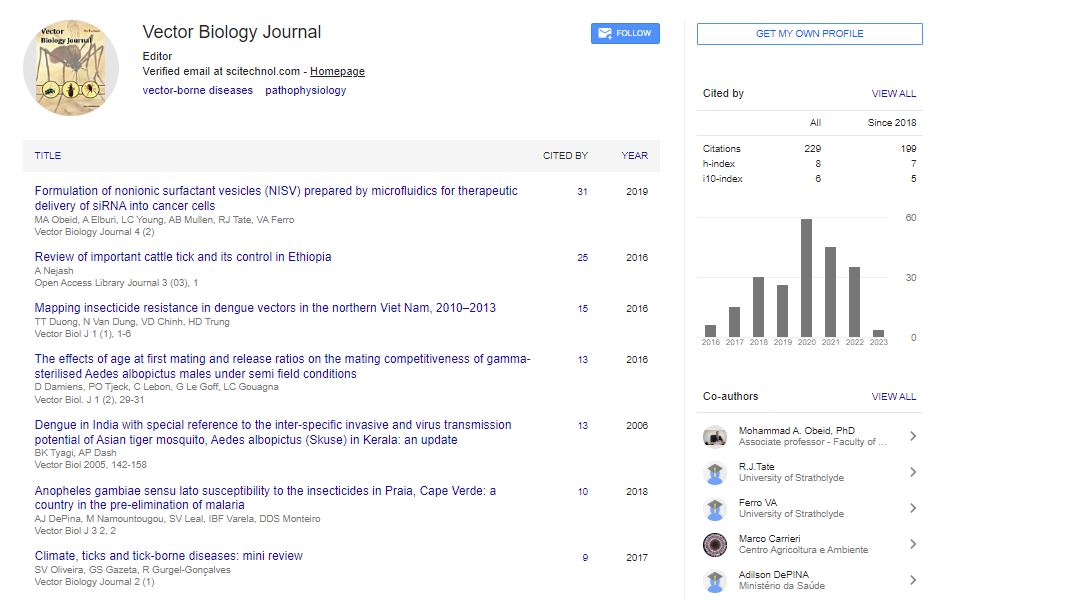Commentary, Vector Biol Vol: 8 Issue: 2
Vector-Borne Diseases: An Overview of Transmission and Prevention
Navjot Chandra*
1Department of Microbiology, Indian Institute of Information Technology, Allahabad, India
*Corresponding Author: Navjot Chandra,
Department of Microbiology, Indian
Institute of Information Technology, Allahabad, India
E-mail:chandranavjot@iita.ac.in
Received date: 30 May, 2023, Manuscript No. VBJ-23-107288;
Editor assigned date: 02 June, 2023, PreQC No. VBJ-23-107288 (PQ);
Reviewed date: 16 June, 2023, QC No. VBJ-23-107288;
Revised date: 23 June, 2023, Manuscript No. VBJ-23-107288 (R);
Published date: 30 June, 2023 DOI: 10.4172/2473-4810.1000262
Citation: Chandra N (2023) Vector-Borne Diseases: An Overview of Transmission and Prevention. Vector Biol 8:2.
Description
Vector-Borne Diseases (VBDs) encompass a broad category of infectious illnesses that are transmitted to humans and animals through the bites of arthropods, such as mosquitoes, ticks, sandflies, and fleas. These diseases pose a significant public health challenge worldwide, affecting millions of individuals annually. Vector-borne diseases have a diverse range of manifestations, from mild to severe, and can lead to long-term complications and even death if left untreated.
Vector-borne diseases have a substantial impact on global health, particularly in tropical and subtropical regions where climatic and socioeconomic factors favor the proliferation of vectors. According to the World Health Organization (WHO), approximately half of the world's population is at risk of contracting vector-borne diseases. These illnesses contribute to an enormous burden of morbidity and mortality, especially in low- and middle-income countries.
Malaria, transmitted by female Anopheles mosquitoes, remains one of the deadliest vector-borne diseases, causing an estimated 405,000 deaths in 2020, primarily in sub-Saharan Africa. Dengue fever, another major concern, affects millions each year, with severe cases leading to hemorrhagic fever and shock syndrome. Other notable vector-borne diseases include Zika virus, Chikungunya, Lyme disease, African trypanosomiasis (sleeping sickness), and leishmaniasis.
Transmission mechanisms of vector-borne diseases
Understanding the transmission mechanisms of vector-borne diseases is important for effective prevention and control. Vectors serve as biological intermediaries, harboring pathogens within their bodies and transmitting them from one host to another. The following are the main transmission mechanisms for some prominent vectorborne diseases:
Mosquito-borne diseases: Mosquitoes are the primary vectors for diseases such as malaria, dengue fever, Zika virus, and yellow fever.
Female mosquitoes become infected with the pathogens when they feed on infected human or animal hosts. Subsequently, they transmit the pathogens to healthy individuals during subsequent blood meals.
Tick-borne diseases: Ticks are responsible for transmitting diseases such as Lyme disease, babesiosis, and tick-borne encephalitis. When ticks attach themselves to a host for a blood meal, they can transfer pathogens present in their saliva into the host's bloodstream.
Sandfly-borne diseases: Sand flies transmit diseases like leishmaniasis, which affects millions worldwide. These tiny insects inject the parasite into the host's bloodstream while feeding, leading to the development of the disease.
Impact and challenges of vector-borne diseases
Vector-borne diseases have a multifaceted impact on individuals, communities, and healthcare systems. The following factors contribute to the challenges associated with these diseases:
Human suffering and mortality: Vector-borne diseases cause substantial morbidity and mortality, leading to decreased productivity, increased healthcare costs, and socio-economic burdens. The most vulnerable populations, including children, pregnant women, and the elderly, bear the greatest burden.
Environmental factors: Climate change, deforestation, urbanization, and human migration influence the distribution and prevalence of vector-borne diseases. Changes in temperature and rainfall patterns can expand the geographic range of vectors, introducing diseases into new regions.
Vector resistance and control: The development of resistance among vectors to insecticides and anti-parasitic drugs poses a significant challenge to disease control efforts. Moreover, vector control interventions, such as insecticide-treated bed nets and indoor residual spraying, require sustained financial and logistical support to be effective.
Lack of vaccines and diagnostic tools: While progress has been made in developing vaccines for some vector-borne diseases like dengue and malaria, many others lack effective preventive vaccines. Diagnostic tools that are affordable, rapid, and accurate are also needed to facilitate early detection and treatment.
Vector-borne diseases continue to threaten global health and demand immediate attention from policymakers, researchers, and healthcare professionals. Concerted efforts are needed to strengthen surveillance systems, improve vector control strategies, enhance public awareness, and develop effective vaccines and treatments. Collaboration between governments, international organizations, and local communities is vital to combatting these diseases and minimizing their impact on vulnerable populations. By addressing the underlying factors that contribute to the spread of vector-borne diseases, we can mitigate their consequences and move closer to a world free from the burden of these preventable illnesses.
 Spanish
Spanish  Chinese
Chinese  Russian
Russian  German
German  French
French  Japanese
Japanese  Portuguese
Portuguese  Hindi
Hindi 